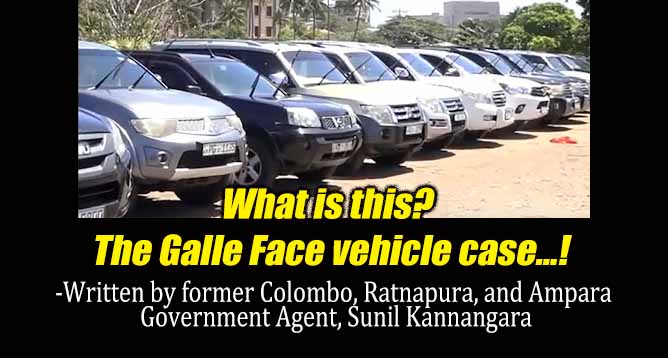-Written by former Colombo, Ratnapura, and Ampara Government Agent, Sunil Kannangara

(Lanka-e-News -29.Sep.2024, 11.30 pm) Galle Face Green in Colombo has historically been a place of significant discussion for various reasons. Though many may not know it today, in the past, what we now call Galle Face was not a part of the city of Colombo. It was originally part of the village of Kollupitiya, located in the Salpiti Korale region. For those who might laugh at the idea of Kollupitiya being a village, it's worth noting that areas such as Bambalapitiya, Wellawatte, Kirulapone, Thimbirigasyaya, and Narahenpita were also villages within Salpiti Korale.
The boundary between the city of Colombo and Salpiti Korale was marked by a narrow waterway that flows from near the present-day Presidential Secretariat into the Indian Ocean. The northern part of this waterway included the Colombo harbor, and after the Portuguese fort was established, this area came to be known as "Fort." I am not writing this to describe the dimensions of Colombo, but to explain the history of Galle Face.
For those traveling from Fort to Galle in the past, Kollupitiya would have been the first village they encountered, which is why it was considered the "Face" or gateway to Galle. Later, during the British era, the famous Galle Face Green was established as an open space, becoming what it is today.
Galle Face is associated with numerous key political events in Sri Lankan history. For example, the first Prime Minister of Sri Lanka, D. S. Senanayake, fell from his horse here, leading to his death. The first rally that initiated the 1953 Hartal was held at Galle Face Green. The inaugural Executive President, J.R. Jayewardene, was sworn in here as well. Notably, the fourth Executive President made a famous statement at Galle Face, claiming that thieves would be caught and hanged in public—a declaration that remains a significant topic in politics today.
Moreover, Galle Face is the location for the annual Independence Day celebrations, offering the ideal setting for the Tri-Forces parade and the simultaneous aerial and naval demonstrations. The former military headquarters at Galle Face was also sold to a hotel company, which was a major controversy at the time.
Later, during the presidency of Gotabaya Rajapaksa, Galle Face was designated as a protest ground, culminating in the "Gota Go Home" movement, where protestors eventually took up residence there. The protests, which included dramatic events like pigeon-culling and counter-attacks, ultimately led to Gotabaya Rajapaksa leaving the country.
These days, Galle Face has been the stage for yet another political drama—a government vehicle exhibition. The media and social media have reported that government vehicles, provided to various individuals by the previous administration, were returned to Galle Face Green after President Anura Kumara Dissanayake took office. However, the manner in which these vehicles were neatly lined up suggests they weren’t just suddenly abandoned.
Former Presidential Secretary Saman Ekanayake has clarified that no vehicles from the Presidential Secretariat were misused and that all vehicles had proper documentation, showing who used them and for what purposes. He emphasized that after President Dissanayake's inauguration, the officials lawfully returned the vehicles they had been using.
Typically, when a President’s term ends, the tenure of his staff also concludes. Those who served the President, from the Secretary to office assistants, either retire or return to their previous posts within the public service. Presidential Secretaries usually leave office immediately after the new President is sworn in.
At the end of every Presidential term, the staff must return any official vehicles assigned to them back to the Presidential Secretariat. In 2015, when Maithripala Sirisena was elected President, many vehicles from the Presidential Secretariat’s fleet were released to other government departments as they were deemed surplus.
It is clear that the political mudslinging regarding vehicles being returned after a new President takes office is not a new phenomenon. In 2015, there was a similar controversy, with accusations about millions of rupees worth of vehicles. However, it was later revealed that one of the politicians who had raised those accusations had been using a government vehicle for two years after leaving office.
Now, President Anura Kumara Dissanayake has an opportunity to set a standard and avoid repeating these controversies. By establishing a clear and minimal staffing policy for the Presidential Secretariat, including the allocation of vehicles, he could create a model for future Presidents to follow.
---------------------------
by (2024-09-29 19:06:45)
Leave a Reply